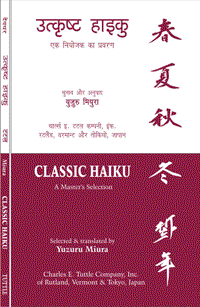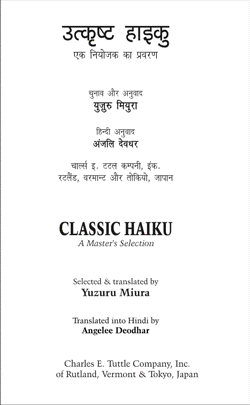
Book Reviews:
New:
David G Lanoue: Haiku Guy: Michael McClintock
Ikumi (Ikuyo) Yoshimura, elephant's eyes
David G Lanoue, Laughing Buddha:Michael McClintock
Dušan Vidaković, S prebolene obale/From the Forsaken Shore: Jadran Zalokar
Milenko D. Ćirović Ljutički, U zagrljaju sjenki/The Embrace of Shadows: Verica Živković
Stefanović Tatjana; Zoran D. Živković: Haiku cvet/ A Haiku Flower: Moma Dimić
===
Flori de tei; Lime-tree flowers: anthology of haiku: From the Forword by Vasile Moldovan
Slavica Blagojević, The Turtledove's Necklace: Vladimir Krasić and Zoran Raonić
Saša Važić, muddy shoes candy heart: Dimitar Anakiev
Gwiazda za Gwiazda, antologia haiku europejskiego: Foreword by Max Verhart

CLASSIC HAIKU, A Master's Selection (Charles E. Tuttle Company, Inc. of Rutland, Vermont & Tokyo, Japan), selected and translated by Yuzuru Miura, translated into Hindi by Angelee Deodhar, cover design: Angelee Deodhar.


From the Preface by Miura Yuzuru
On the following pages are English translations of one hundred Japanese haiku written by ancient greats – Basho, Buson, and Issa -- and celebrated moderns – Shiki, Kyoshi, and Dakotsu. As the criterion for choosing the poems was literary merit rather than historical significance, Basho's well-known haiku about the frog and the old pond is not included in the collection. The poet Takahama Kyoshi has stated that Basho's poem reveals the starting point of Basho's direct natural description but the poem is more important for its historical significance than for its artistic attainment.
For people unfamiliar with Chinese characters, each haiku in the volume is printed in romaji, the Romanized form of Japanese. An additional reason for including the romaji is that although the assonance, onomatopoeia, and other poetic features of the original Japanese cannot be satisfactorily reproduced in the English translation, such features are apparent in the romaji.
One way to think of a haiku is as a kind of word picture dotted with images on its canvas. Such thinking let to the inclusion of illustrations and calligraphy to accompany certain poems.
Composing verse in the traditional seventeen-syllable form remains very popular in modern Japan. I sincerely hope that this little book will be a great help in promoting haiku in both the East and the West.
From the Hindi Translator's Note
Haiku is being written in many regional languages, specially in Hindi. Perceiving the paucity of haiku related resources and the increasing popularity of this poetic genre in India, I decided to translate this book.
It has been a challenge to translate and present these haiku in ordinary, everyday Hindi in a modern format which leaves behind the five-seven-five syllable count to which Indian haiku poets have become accustomed.
It is hoped that this bilingual book will help to introduce to Indian haiku poets the wide range of haiku written by Japanese masters.
Dr. Angelee Deodhar
India June, 2006
Editor's Selection




